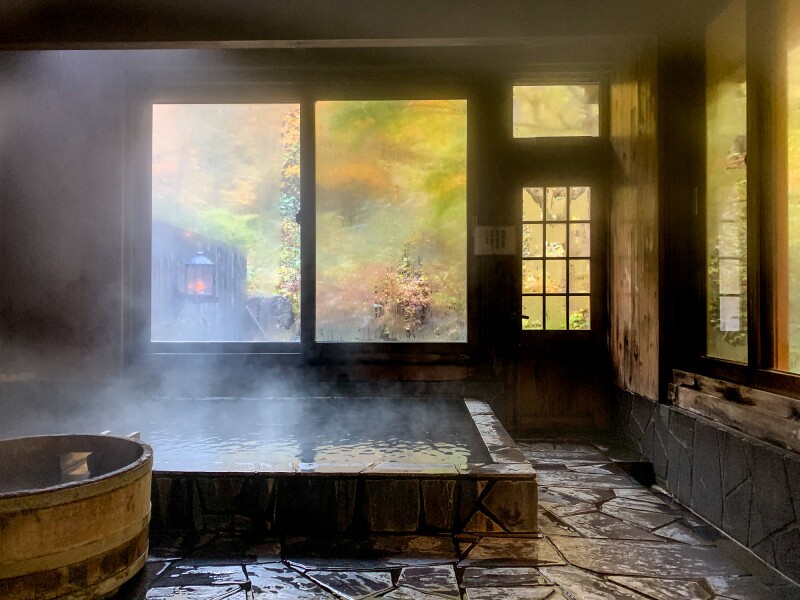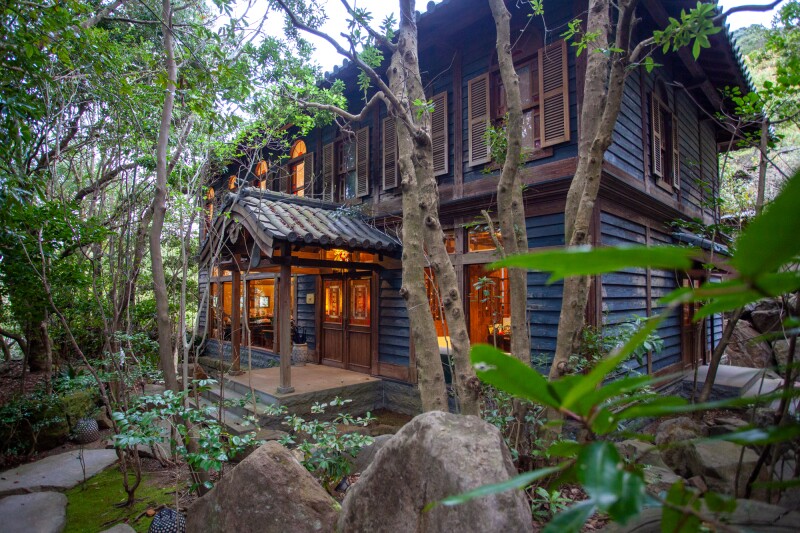Thanks to Japan’s volcanic terrain, its hot springs—referred to as onsen in Japanese—are found all over the country (the total number of onsen resorts is estimated to be more than 3,000) and form an integral part of daily life. A visit to an onsen is an opportunity to join residents in a local activity that is tenderly embraced not only for its soothing effect on the body but also for its part in the country’s history, culture, and literature—including works by the country’s Nobel laureates.
Among thousands of onsen options, here are seven experiences that stand out, including hot springs in mountains and forests and hidden beside the ocean. Each promises a very different—yet equally soothing—experience.
1. Kurokawa Onsen
- Location: Kurokawa Onsen Village in Kumamoto Prefecture
- Come for: onsen hopping opportunities
- Book now: Kurokawa Onsen Ryokan Association
Kurokawa Onsen delivers a traditional onsen-town atmosphere, thanks to its commitment to wooden buildings instead of multistory concrete facilities. The town is home to many ryokan (traditional Japanese inns), each featuring their own onsen. A river flows through the small town where short bridges lead to onsen facilities.
Home to nearly 30 ryokan, Kurokawa is a wonderful destination for onsen hopping from one spring to another. Guests can purchase an onsen pass—sold at the village’s tourism information center and ryokans—that allows access to multiple onsen at a reduced price.

Hokkein Onsen is best visited in late May, when the Kyushu azaleas are in full bloom.
Photo by Burcu Basar
2. Hokkein Onsen Sanso
- Location: Northern part of Aso-Kuju National Park in Oita Prefecture
- Come for: ultimate seclusion
- Book now: Hokkein Onsen; booking only possible by phone
Hokkein Onsen Sanso served as a Buddhist temple 800 years ago during the Kamakura era and is one of the most rewarding hot spring experiences in Japan, accessible only to those willing to hike for two to three hours. Located in the northern section of Aso-Kuju National Park, Hokkein sits in the middle of the volcanic Kuju Mountain Range and Bogatsuru wetland. Open in all seasons, the onsen is particularly popular in late May when pink azalea flowers cover the mountainous region. Guests can stay overnight in private or dorm-style rooms.

Karakonoyu, located in Ganiba Onsen, is one of the most atmospheric baths in Nyuto Onsen Village.
Photo by Burcu Basar
3. Nyuto Onsen Village
- Location: Nyuto Onsen Village, in Akita Prefecture
- Come for: a fantastic winter onsen experience
- Book now: Nyuto Onsen Village
Nyuto Onsen dates back to the 17th century as a popular healing spot for the feudal lords of Akita. This hot spring village is located at the foot of Mount Nyuto. Within the village, there are seven different onsen facilities, each drawing its waters from a different spring. Some of the onsen, such as Tsurunoyu, have a more traditional and rustic aura and feature only Japanese-style rooms. There are also modern options such as Kyukamura that offer both Japanese and Western-style rooms and open buffet dining.
Beautiful in every season, the village is particularly popular in the winter when the snow-covered beech forest makes the mesmerizingly blue onsen waters shine. Locals and travelers can spend a day or two onsen-hopping here using the “onsen shuttle” that, in a playful Japanese style, features a decorative barrel bathtub on top.

Heal after a full day of hiking in Hirauchi Onsen.
Photo by Burcu Basar
4. Hirauchi Kaichu Onsen
- Location: Hirauchi town, Yakushima Island in Kagoshima Prefecture
- Come for: sunset and stargazing in the comfort of warm onsen water
Hirauchi Kaichu Onsen stands out not only for its picturesque location right in the ocean but also for the way it’s formed: Here, oceanside rocks protect small hot-spring pools accessible only during low tide. At high tide, the pools are completely submerged. Come for a soak after a day of hiking the island’s numerous forested trails (parts of Yakushima Island are a UNESCO World Heritage site), but note that the onsen is public and doesn’t have any accommodations attached. Open at all hours during low tide, the onsen is also a very popular spot for sunset viewing and stargazing.

Aoni Onsen is home to baths like Takimi-no-Yu.
Photo by Burcu Basar
5. Lamp no Yado Aoni Onsen
- Location: Kuroishi, Aomori Prefecture
- Come for: disconnecting from the modern world in a setting straight out of a novel
- Book now: Aoni Onsen
Aoni Onsen, founded in 1929, is located by a mountain stream in the remote forests of Aomori and feels straight out of the many works of Japanese literature set in onsen towns (such as Yasunari Kawabata’s Snow Country). This is a place to disconnect from the modern world and get a glimpse of old Japan: There is no electricity or phone reception and the entire facility—including its four baths—is lit with oil lamps. Most guests usually wear a yukata, the cotton kimono that translates to “bathing clothing,” adding to the atmosphere reminiscent of Edo period Japan.

Goso-ku-no Kutsu Onsen is located on the historical Amakusa Islands.
Photo by Burcu Basar
6. Goso-ku-no Kutsu Onsen
- Location: Shimoda Onsen village in Amakusa Island, Kumamoto Prefecture
- Come for: privacy on a historically eventful island
- Book now: Goso-ku-no Kutsu Onsen
Goso-ku-no Kutsu Onsen is located in a small fishing village in Amakusa Islands—an archipelago of 120 islands off the coast of Kumamoto in Kyushu. Amakusa was one of the important hubs of cultural exchange between Japan and the West during the 16th century when the first Portuguese ships arrived in Japan, initiating Japan’s acquaintance with Western culture. For decades, the island had also hosted Japan’s hidden Christians who called the remote island home. They were here to avoid persecution by authorities when Christianity was banned in Japan during the Edo period, an event depicted in Martin Scorsese’s movie Silence.
Goso-ku-no Kutsu Onsen’s owner, a local of Amakusa Islands, is devoted to keeping the memory of local history alive. Christian hymns are played in the hall leading to the private dining rooms. Traditional Japanese-style bedrooms accompanied by living rooms with rustic furniture and colorful Turkish carpets pay homage to the islands’ openness to the other cultures. Each group of guests stays in a private villa where they have access to their own private outdoor bath known as a rotenburo. Breakfast and dinner, featuring mainly local seafood dishes, are also served in private dining rooms.

KAI Kirishima directly faces the Sakurajima Volcano.
Photo by Burcu Basar
7. KAI Kirishima Onsen Resort
- Location: Kirishima in Kagoshima Prefecture
- Come for: a luxurious stay where culinary satisfaction is a priority
- Book now: KAI Kirishima
Opened in 2021, KAI Kirishima is one of the new editions to the onsen sub-brand—KAI—of Japan’s luxury resort chain Hoshino. Located in the southern part of Kyushu, KAI Kirishima is situated by the Kirishima Mountains, where each room offers uninterrupted views of the Sakurajima Volcano.
Among the 49 spacious rooms, some of the upper-floor rooms include a semi-outdoor private onsen. The common baths open to all guests sit in the middle of a field of silvergrass and are accessible with a short monorail ride from the main building.
Meals at the onsen resort are served kaiseki style (traditional Japanese multicourse meal). In addition to breakfast and dinner courses of dishes cooked with seasonal local ingredients—such as local pork shabu shabu (hot pot)—and served in semi-private dining rooms, KAI Kirishima also offers tasting experiences outside of the dining hours to introduce guests to local delicacies: One cocktail tasting experience pairs Kirishima tea with locally brewed shochu (a Japanese spirit).
To learn more about Japan’s hot springs, take a look at Kristin Braswell’s guide to the thousands of onsen in Oita.











